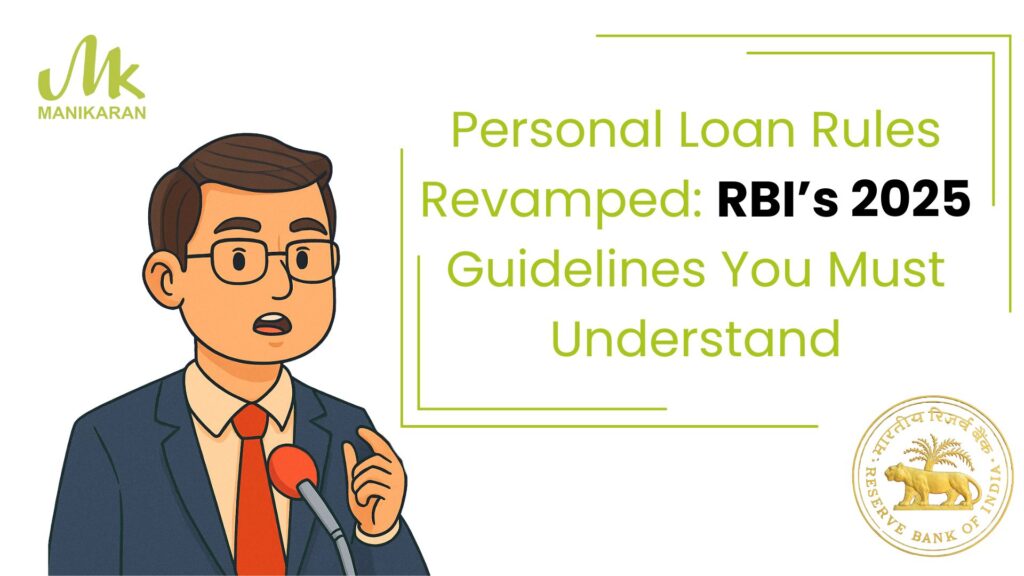The Reserve Bank of India (RBI) regularly revises its lending policies to ensure the financial system is more secure and transparent for lenders and borrowers alike. In 2025, the RBI made a few key alterations in personal loan rules that have a direct bearing on loan sanctioning, disbursal, and recovery.
Whether you are going to apply for a fresh personal loan or are already servicing one, it is essential to know these new RBI rules. Let’s see what has changed and how the changes impact you.
1. Stricter Regulations on Mobile Loan Apps
In recent years, thousands of Indians have fallen prey to fake or unregulated digital loan apps. To protect borrowers, the RBI’s 2025 guidelines made it mandatory for all lending apps to be directly linked to a registered bank or NBFC.
Key updates:
Apps must clearly display the name of the registered lender.
All loan disbursals and repayments must go directly between the borrower’s and the bank’s account — no third-party wallets allowed.
Apps should demonstrate complete fee transparency, processing fees, and interest rates prior to loan sanction.
???? What it means for you:
Always ensure the lending portal is RBI-approved or has a connection with a registered NBFC prior to applying.
2. Mandatory Cooling-Off Period for Borrowers
The RBI now compels lenders to provide a “cooling-off period” following loan sanction — a brief timeframe (typically 3–7 days) during which borrowers may renege on the loan without charges if they have a change of heart.
This regulation is aimed at avoiding frivolous borrowing and safeguarding lenders against concealed expenses.
???? What this means for you:
If you feel coerced to accept a loan or are dissatisfied with the terms once approved, you can back out within this timeframe without forfeiting money.
3. Toughest Disclosure of All Fees
Previously, numerous borrowers complained that they were not informed about processing charges, prepayment charges, or insurance enhancements until after signing a contract.
The RBI’s 2025 guidelines now obligate lenders to show a Key Fact Statement (KFS) prior to loan disbursal.
The KFS should contain:
Interest charge (annual percentage rate or APR)
Fee for processing and other fees
Schedule of repayment and due dates
Information on insurance or add-on products
???? What this means for you:
No surprise fees! All the costs involved with your personal loan have to be disclosed upfront, before you accept the offer.
4. Clear Rules on Loan Recovery Practices
To deal with increasing harassment complaints from recovery agents, RBI has made its Fair Practices Code (FPC) for recovery of loans stricter.
Highlights:
Agents can approach borrowers only from 8 AM to 7 PM.
Harassment, threat, or shaming in public is strictly ruled out.
Borrowers have to be given a written notice prior to recovery visits.
Banks and NBFCs are held directly accountable for the actions of their agents.
???? What this means for you:
If you are harassed by recovery agents, you may approach the lender or RBI for a complaint. Recovery must always be done respectfully and legally.
5. Credit Scoring and Sharing of Information Transparency
In 2025, RBI prioritized data privacy and consent-based sharing of credit data.
Lenders can now access or share your credit information only after your clear consent, and only to assess your loan.
Besides, the borrowers now also get the facility to challenge discrepancies in their CIBIL or other credit bureau reports directly from the lender’s grievance platform.
???? How this benefits you:
Your financial information is more secure, and you get greater control over its usage. Always check your CIBIL report carefully for correctness on a regular basis.
6. Uniform Interest Rate Disclosure (APR System)
To help borrowers compare loans easily, the RBI introduced the Annual Percentage Rate (APR) system for personal loans in 2025.
Unlike just mentioning the interest rate, APR reflects the total cost of the loan, including processing fees and other charges.
???? What this means for you:
You can now compare loans more fairly — because all costs are combined into a single, easy-to-understand percentage.
7. Improved Grievance Redressal Mechanism
Borrowers find it difficult to get the correct contact while experiencing problems. The RBI now requires all lenders to:
Have a grievance redressal officer.
Respond to complaints within 30 days.
Publish complaint details prominently on their website and loan app.
If your problem is not solved, you may approach the RBI Ombudsman under the Integrated Ombudsman Scheme.
???? How this affects you:
You now have a clear, time-bound channel to raise issues and get fair resolution.
8. Regulation on Loan Restructuring & Foreclosure
RBI’s 2025 circular also simplified the process for loan restructuring in case of genuine financial distress. Borrowers can request restructuring due to job loss, illness, or emergencies — without their CIBIL score taking a severe hit (if reported properly).
The RBI has also directed lenders to:
Eliminate excessive foreclosure or prepayment charges on floating-rate personal loans.
Communicate clearly the outstanding total and dues prior to restructuring.
???? What this means for you:
You can take it easy with repayment if you encounter financial troubles, without being stuck in hefty penalties.
9. Monitoring of High-Risk Borrowers
The RBI has asked banks and NBFCs to enhance risk assessment in case of multiple simultaneous loans or high short-term borrowing.
In order to prevent defaults, lenders now have to:
Monitor a borrower’s overall debt exposure across institutions.
Notify high-risk profiles to credit bureaus in real time.
???? What this implies for you:
Repetitive loan applications across sites can now hit your credit reputation harder — borrow responsibly.
10. Fostering Financial Literacy
As part of its 2025 initiative, RBI collaborated with banks and fintechs to encourage financial literacy drives. Borrowers must know the effect of interest rates, delayed payments, and CIBIL scores before availing any loan.
???? What this means for you:
More awareness campaigns, online workshops, and lender transparency that assist you in making smarter borrowing choices.
How These Changes Benefit Borrowers
Old SystemubreNew RBI 2025 Guidelines
Hidden charges and ambiguous terms\tClear Key Fact Statements (KFS)
Harassment of recovery agents\tRegulated and time-bound recovery procedure
No means to cancel once approved\tCooling-off period implemented
Complex comparison of loan deals\tAPR system for improved loan comparison
Inadequate grievance system\tStrong, time-bound redressal process
Conclusion
The 2025 RBI regulations on personal loans are a significant move towards ethical lending, transparency and protection of borrowers. From cooling-off periods and structured recovery procedures to improved disclosure and grievance redressal — these reforms ensure that you lend safely and with confidence.
If you are applying for a personal loan, ensure that your lender adheres to RBI’s new guidelines and issues a Key Fact Statement. Awareness about these rules can prevent you from paying excess charges, becoming agitated, and getting into trouble later.
Pro Tip:
Carefully read the fine print before signing the loan document. A bit of awareness today can prevent you from shelling out thousands tomorrow.



